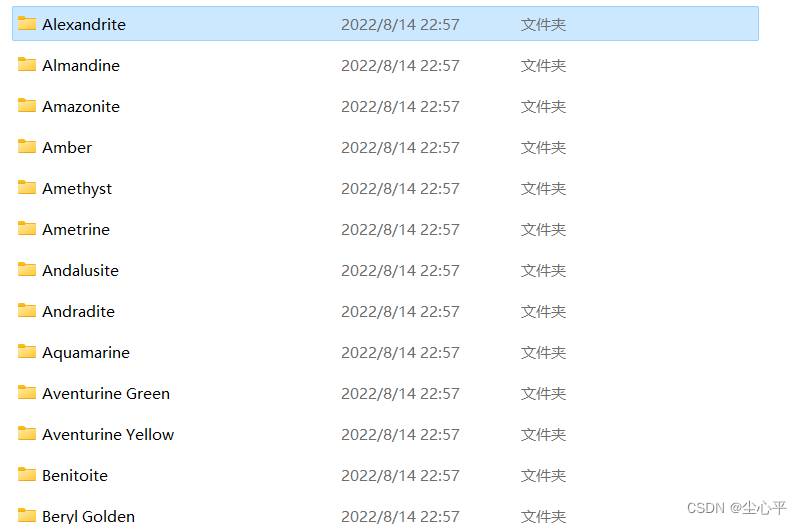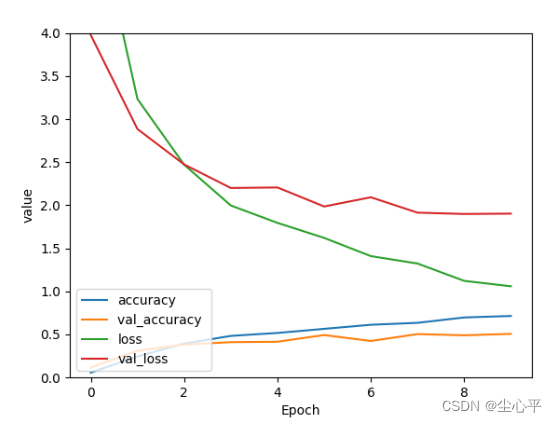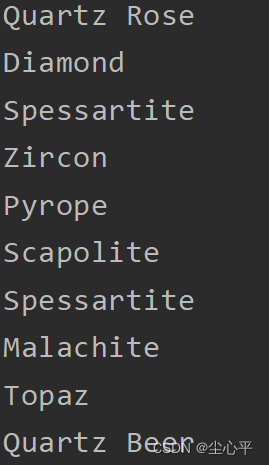活动地址:CSDN21天学习挑战赛
数据集下载
可以在百度飞桨AI Studio中下载数据集,下载地址如下:
宝石数据集(Gemstones) - 飞桨AI Studio
数据集已分好训练集和测试集,如下图:
数据集采取文件夹名为标签名的形式,共有87种分类
数据集导入
采用 keras.preprocessing.image.image_dataset_from_directory 方法导入数据集
这里由于子目录太多,采用 os.listdir 获取子目录列表即标签列表
- 设置路径
设置路径(\换/) 采用os.listdir设置标签 设置图片大小
train_dir = "E:/Download/data_set/Gemstones/train" test_dir = "E:/Download/data_set/Gemstones/test" class_names = os.listdir(train_dir) # 通过os.listdir获取标签列表 image_width = 128 image_height = 128
- 导入训练集
因为训练集已分好,这里不再设置函数的subset和validation_split,直接读取即可
train_data = keras.preprocessing.image.image_dataset_from_directory( directory=train_dir, class_names=class_names, image_size=(image_height, image_width), seed=123 )
- 导入测试集
因为测试集已分好,这里同训练集一样,不再设置subset和validation_split
test_data = keras.preprocessing.image.image_dataset_from_directory( directory=test_dir, class_names=class_names, image_size=(image_height, image_width), seed=123 )
- 设置预取加快训练速度
采用cache()和prefetch()函数预取
train_data = train_data.cache().shuffle(1000).prefetch(tf.data.AUTOTUNE) test_data = test_data.cache().prefetch(tf.data.AUTOTUNE)
构建CNN网络模型
这里采用models.Sequential构建网络模型,且由于过拟合,采用正则化和Dropout
model = models.Sequential([ layers.Rescaling(1 / 255.0, input_shape=(image_height, image_width, 3)), layers.Conv2D(128, (3, 3), padding="same", activation="relu",kernel_regularizer=keras.regularizers.L1L2(0.03)), layers.MaxPooling2D(), layers.Conv2D(128, (3, 3), activation="relu", padding="same"), layers.MaxPooling2D(), layers.Conv2D(256, (3, 3), activation="relu", padding="same"), layers.MaxPooling2D(), layers.Flatten(), layers.Dropout(0.6), layers.Dense(256, activation="relu"), layers.Dense(87) ])
编译运行神经网络
# 编译训练网络模型 model.compile(optimizer="adam", loss=tf.keras.losses.SparseCategoricalCrossentropy(from_logits=True), metrics=['accuracy']) history = model.fit(train_data, validation_data=test_data, epochs=10)
评估模型
# 输出网络模型loss、val_loss变化曲线 plt.plot(history.history['accuracy'], label='accuracy') # 训练集准确度 plt.plot(history.history['val_accuracy'], label='val_accuracy ') # 验证集准确度 plt.plot(history.history['loss'], label='loss') # 训练集损失程度 plt.plot(history.history['val_loss'], label='val_loss') # 验证集损失程度 plt.xlabel('Epoch') # 训练轮数 plt.ylabel('value') # 值 plt.ylim([0,4]) plt.legend(loc='lower left') # 图例位置 plt.show()
预测测试集
# 预测 pre = model.predict(test_data) for i in range(20): print(pre[i]) for i in range(20): print(class_names[numpy.array(pre[i]).argmax()]) # 绘画数据集图像,查看导入是否完成 plt.figure(figsize=(20, 10)) for test_image, test_label in test_data.take(1): for i in range(20): plt.subplot(5, 10, i + 1) plt.xticks([]) plt.yticks([]) plt.grid(False) plt.imshow(test_image[i].numpy().astype('uint8') / 255.0, cmap=plt.cm.binary) plt.xlabel(class_names[test_label[i]]) plt.show()这里预测测试集前20个
正确率大概只有0.5很不理想,后续仍要改进
保存模型
这里采用SavedModel方法保存模型
save_path = "net/Gemstones" model.save(save_path)




